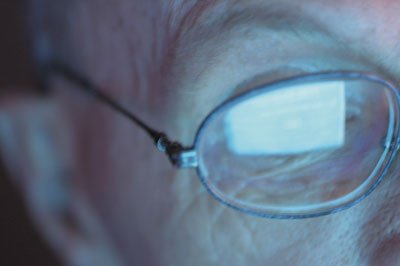I went to church Sunday and something interesting happened that
really solidified the importance of acknowledging and talking about
vision loss.
I went to church Sunday and something interesting happened that really solidified the importance of acknowledging and talking about vision loss.
One of our “elder” elders had prepared a piece to share with the congregation. He had trouble reading his notes and confessed that his “old eyes” weren’t working well anymore, especially when the lights were low. Then the light directly above him became brighter.
Miraculous? No. Simple? Yes. The “behind the scene” members of the congregation in charge of lighting and sound had just simply shed some light on the situation.
Jon Nussbaum, author of “Communication and Aging,” tells us that by the age of 70, fewer than 30 percent of elderly people have 20/20 eyesight and that most do not have normal eyesight even with correction. If you have elderly friends or family members, chances are you have heard the words presbyobia, cataracts or senile macular degeneration.
Around the age of 40, our eyesight begins to decline due to presbyobia, which literally means “old eyes.” According to Nussbaum, over time presbyobia will affect one’s ability to focus. Choosing to ignore these symptoms at their onset may make your symptoms worse in the long run. Since glasses or bifocals are typically needed as we age, it’s important to get your eyes checked regularly and keep prescriptions current.
Cataracts and senile macular degeneration typically occur later in life. Nussbaum reports that nearly 25 percent of elderly people who suffer with cataracts are partially or totally blind. Try to “see things” from their perspective.
Dr. Leilani Feliciano, a gerontological psychologist, suggests purchasing a pair of clear safety goggles and smearing the lenses with Vaseline to imitate the “cloudy” effect of cataracts. For senile macular degeneration, an eye disease that can leave you to rely solely on your peripheral vision, Feliciano suggests pasting two, black nickel size circles onto the middle of each of the lenses of the goggles.
Try to read the newspaper, have a conversation, read the labels on your prescription drug bottles, make a sandwich, fill out a check or complete a Medicare application. You can take the goggles off, but the elderly have to live with these problems everyday. Ask them about their experiences and ask them if there is anything you can do to help.
It becomes evident that eye problems can interfere with everyday activities. In addition to keeping us safe and secure, Nussbaum says that our senses play an important role in our communicative interactions. He says that since many of the nonverbal cues we use in conversation are visual, a diminished capacity to process visual information makes conversations difficult.
Consider things that take place during a conversation aside from the verbal exchange … facial expressions not only help to indicate emotion, they also indicate turn taking cues. Hand gestures act as illustrators (“The fish was this big”). Head nodding can be indicative of “yes” or “no.” Most importantly however, we observe our partners to gain feedback and to “see” if they get what we are saying.
If a person with visual impairments can’t see the tears in your eyes, they may not respond with the proper emotion; you may perceive them as cold. If they can’t see that it is their turn to respond, they may interrupt us before we are done speaking; you may perceive them as rude. If they can’t see that we are nodding our heads while they speak, they may think that we are impartial to what they are saying.
When you are talking to an elderly person who has visual impairments, remember they may be relying very heavily on their hearing to compensate for their vision loss. Try to speak a little slower and enunciate better. If their vision loss is severe, identify yourself when approaching them. Be more detailed and offer more descriptors in your verbal exchanges. We cannot stop ourselves from making facial expressions when we talk, but try to translate these communicative tendencies into words.
Express your emotions, share how happy you are. Describe colors and textures. When you are done speaking offer prompts, “Isn’t that amazing grandma?” And instead of nodding your head when they speak, make sure you say things like, “Yes, I agree.”
Your physical and mental presence is important to anyone who is suffering from vision loss. Your words can help them stay connected and participate with confidence in conversations.














